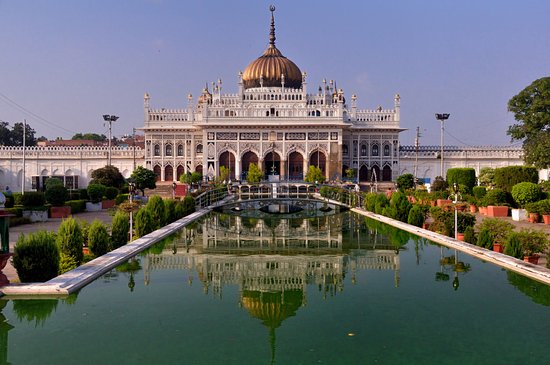
Chota Imambara
Chota Imambara, also known as Imambara Hussainabad Mubarak is an imposing monument located in the city of Lucknow, Uttar Pradesh, India. It took 54 years to finalize it. Built as an imambara or a congregation hall by Muhammad Ali Shah, the Nawab of Awadh in 1838, it serves as a mausoleum for himself and his mother, buried beside him.
Lucknow is full of stellar examples of Nawabi architecture, but few compare to the Chhota Imambara, built by Nawab Muhammad Ali Shah in 1838. The Nawab’s mausoleum, as well as his mother’s, are present here. The complex comprises the tomb of Princess Zinat Algiya, the daughter of the king of Awadh, a watchtower known as Satkhanda, a ceremonial gateway called Naubat Khana Husainabad mosque. The Chhota Imambara boasts a gilded dome, several turrets, and beautiful chandeliers. It comprises five doorways and Islamic verses have been carved into its exterior walls. There are two main halls, namely Shenasheen and Azakhana. The latter is embellished with gilt-edged mirrors, colorful stuccos, and exquisite chandeliers that have been brought from Belgium. Because of these lamps and crystal chandeliers, this iconic building is also known as the palace of lights. The Imambara stands to the west of the Bara Imambara, with the exterior of the building boasting a golden dome with fine calligraphy. It is at its finest during festivals and other special occasions when the whole structure is lit up and glimmers like a jewel. The significance of Panjetan, the holy five, is emphasized here with five main doorways. This Imambara consists of two halls and a Shehnasheen (a platform where the Zarih of Imam Husain is kept.) Zarih is the replica of that protective grill or structure which is kept at the grave of Imam Husain at Karbala, Iraq. It is situated near the Bara Imambara and on the connecting road stands an imposing gateway known as Rumi Darwaza. The building is also known as the Palace of Lights because of its decorations and chandeliers during special festivals, like Muharram. The chandeliers used to decorate the interior of this building were brought from Belgium. Also housed within the building is the crown of Muhammad Ali Shah and ceremonial tazias. Thousands of laborers worked on the project to gain famine relief. It has a gilded dome and several turrets and minarets. The tombs of Muhammad Ali Shah and other members of his family are inside the imambara. It includes two replicas of the Taj Mahal, built as the tombs of Muhammad Ali Shah's daughter and her husband. The walls are decorated with Arabic calligraphy. Water supply for the fountains and the water bodies inside the imambara came directly from the Gomti River.

